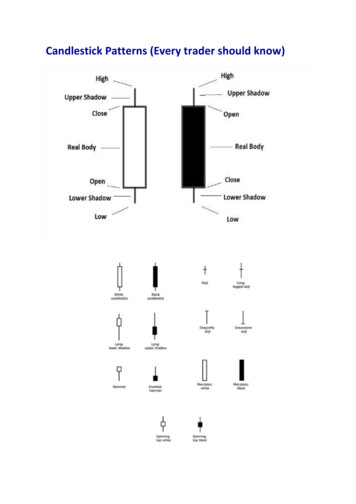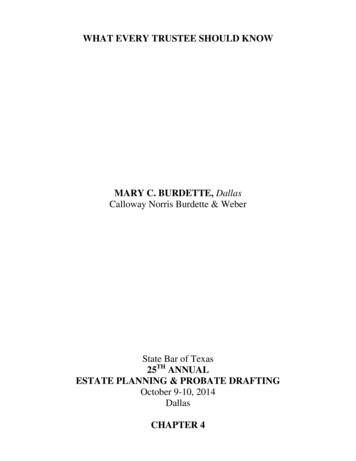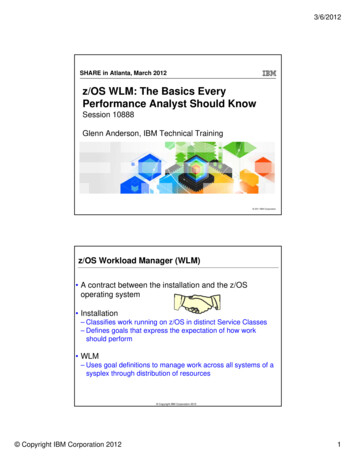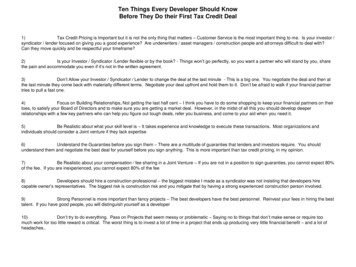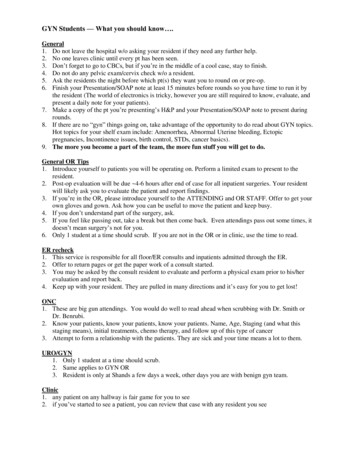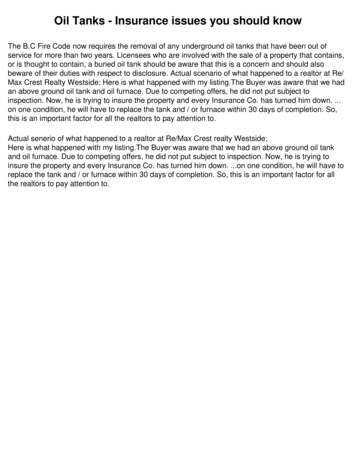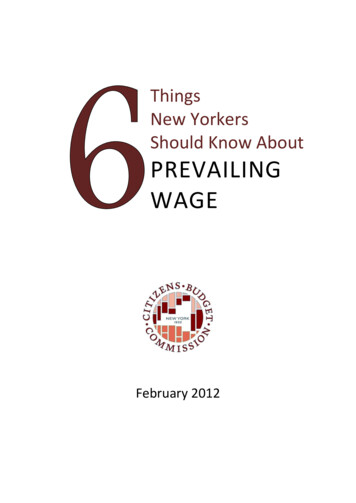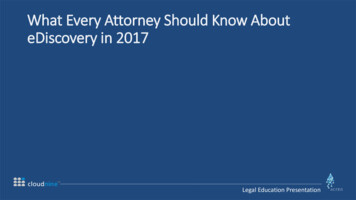
Transcription
What Every Attorney Should Know AbouteDiscovery in 2017Legal Education Presentation
OverviewLegal Education Presentation Sponsor and Presenter CredentialsKey Electronic Discovery TermsPhases of the Electronic Discovery Life CycleRules Regarding Electronically Stored InformationCompetency Ethical Duties of AttorneysTop Ten Important Cases to the Evolution of eDiscovery Best PracticesUseful Resources for eDiscovery Continued EducationQuestions and ConsiderationsWhat Every Attorney Should Know About eDiscovery in 2017
StatementMandatory Continuing Legal EducationThis course has been approved for Minimum Continuing Legal Education credit bythe State Bar of Texas Committee on MCLE in the amount of 1.0 credit hours ofwhich 0.25 credit hours will apply to legal ethics/professional responsibility credit.Course No: 928000611This course has been approved for CLE in Texas ONLY. If applicable, others whoattend may choose to apply for out-of-state CLE credit on their own.What Every Attorney Should Know About eDiscovery in 2017
CloudNineSponsor CredentialsCloudNine empowers legal, information technology, and business professionalswith eDiscovery automation software and professional services that simplifylitigation, investigations, and audits for law firms and corporations. Founded in 2002 in Houston, TexasNational Focus with Local PresenceDirect (End User) and Indirect (Partner) Engagement ModelWhat Every Attorney Should Know About eDiscovery in 2017
CloudNinePresenter Credentials Doug Austin: Doug is the Vice President of Operations and Professional Services for CloudNine. At CloudNine,Doug manages professional services consulting projects for CloudNine clients. Doug has over 25 years ofexperience providing legal technology consulting, technical project management and software developmentservices to numerous commercial and government clients. Doug is also the editor of the CloudNine sponsoredeDiscovery Daily blog, which has become a trusted resource for eDiscovery news and analysis and is an EDRMEducation partner. Karen DeSouza: Karen is the Director of Review Services, In-House Counsel, and a Professional ServicesConsultant for CloudNine. Also, Karen helps attorneys with CloudNine's software and Pre-Litigation ConsultingServices. Karen is a licensed attorney in Texas and has over 15 years of legal experience. She also has a Bachelorof Science in Legal Studies - American Jurisprudence. Before CloudNine, Karen worked as an E-DiscoveryDirector, Project Manager, and as an Associate at various law firms in Houston area where her primary focuswas litigation.What Every Attorney Should Know About eDiscovery in 2017
Key Electronic Discovery Terms Claw-back Agreement: An agreement that protects against waiver of privilege and/or workproduction protections when inadvertent production occurs. See Federal Rule of Evidence 502. Inthis order, the return of inadvertently disclosed records is automatic and does not require a showingof reasonable steps to prevent disclosure. Deduplication (“Deduping”): The process of comparing electronic records and removing or markingduplicates within a data set. Deduplication can be done within custodians, but is most commonlydone across the corpus of the data. Duty to Preserve: Duty arising under state and federal law, upon reasonable anticipation oflitigation, to preserve documents, electronic records and data, and any other evidence orinformation potentially relevant to a dispute.What Every Attorney Should Know About eDiscovery in 2017
Key Electronic Discovery TermsWhat Every Attorney Should Know About eDiscovery in 2017
Key Electronic Discovery Terms Electronically Stored Information (ESI): Information that is stored electronically (regardless of themedia or original formatting) as opposed to paper. Family: Used to identify related documents, typically when referring to emails and attachments.The email is typically referred to as the “parent” and the attachments as the “children”. Litigation Hold (or Legal Hold): Communications issued upon notice of a duty to preserve, andinstructing individuals and entities in the efforts required to ensure adequate preservation ofpotentially relevant evidence. Metadata: Data (stored electronically) describing the characteristics of specific ESI that can be foundin different places and different forms. Practice Note: The duty to preserve includes metadata.What Every Attorney Should Know About eDiscovery in 2017
Key Electronic Discovery Terms Native Format: An electronic document’s original form, as defined by the application that was usedto create the document. Sometimes documents are converted from their native format to animaged format, such as TIFF or PDF. Once converted, the original metadata cannot be viewed. Record Custodian: Individual responsible for the physical storage and protection of records.Custodian may also refer to various individuals with knowledge and/or possession of, or whocreated, sent, received and/or stored emails, documents and other data relevant to an ongoing orpotential dispute. Spoliation: The destruction of evidence and information that may be relevant to ongoing orreasonably anticipated litigation, government audit or investigation. Courts differ as to the requisitelevel of intent required for imposition of sanctions, with fault (possession and failure to preserve) onone end and willfulness on the other.For more terms, check out the Electronic Discovery: Glossary of 123 Commonly Used Terms by Lane Powell PC.What Every Attorney Should Know About eDiscovery in 2017
Phases of the eDiscovery Life CycleWhat Every Attorney Should Know About eDiscovery in 2017
Phases of eDiscovery Life CycleInformation Governance Reference Model (IGRM)Information GovernanceThe set of multi-disciplinary structures,policies, procedures, processes and controlsimplemented to manage information at anenterprise level, supporting an organization'simmediate and future regulatory, legal, risk,environmental and operational requirements.Sedona Principle #1: Electronically stored information is generally subjectto the same preservation and discovery requirements as other relevantinformation.What Every Attorney Should Know About eDiscovery in 2017
Phases of eDiscovery Life CycleInformationGovernanceWhy is Information Governance important? Every 2 days we create as much information as we did from the beginning of time until 2003 Data is growing faster than ever before and by the year 2020, about 1.7 megabytes of newinformation will be created every second for every human being on the planet. By 2020, our accumulated digital universe of data will grow from 4.4 zettabytes today to around 44zettabytes, or 44 trillion gigabytes. We perform 40,000 search queries every second (on Google alone), which makes it 3.5 billionsearches per day and 1.2 trillion searches per year. If you burned all of the data created in just one day onto DVDs, you could stack them on top of eachother and reach the moon – twiceFor more facts, check out Just How “BIG” is Big Data Getting? Check Out These Facts – eDiscovery TrendsWhat Every Attorney Should Know About eDiscovery in 2017
Phases of eDiscovery Life CycleIdentificationIdentificationLocating potential sources of ESI and determining the scope, breadth and depth of that ESI.Two main components in Identification include: Early Case Assessment: Assess case value, strategy, risk analysis, legal hold requirements, etc. Early Data Assessment: Interview records management personnel, potential custodians andinformation management personnel to determine potential locations and types of relevant ESI.Sedona Principle #3: As soon as practicable, parties should confer and seek to reach agreement regarding the preservation and productionof electronically stored information.What Every Attorney Should Know About eDiscovery in 2017
Phases of eDiscovery Life CyclePreservation and Collection Preservation: Ensuring that ESI is protected against inappropriate alteration or destruction. Collection: Gathering ESI for further use in the eDiscovery process.PreservationThe stages are together in the model because, often, you preserve by collecting.CollectionSedona Principle #5: The obligation to preserve electronically stored information requires reasonable and good faithefforts to retain information that is expected to be relevant to claims or defenses in reasonably anticipated or pendinglitigation. However, it is unreasonable to expect parties to take every conceivable step or disproportionate steps topreserve each instance of relevant electronically stored information.What Every Attorney Should Know About eDiscovery in 2017
Phases of eDiscovery Life CyclePreservationAim: When duty to preserve is triggered, promptly isolate and protect potentially relevant data in ways thatare: legally defensible; reasonable; proportionate; efficient; auditable; broad but tailored; mitigate risks.Goal: Mitigate risks.PreservationWhat Every Attorney Should Know About eDiscovery in 2017
Phases of eDiscovery Life CycleCollectionAlthough represented as a linear workflow, moving from left to right, this process is often iterative.CollectionWhat Every Attorney Should Know About eDiscovery in 2017
Phases of eDiscovery Life CycleProcessing, Review, and Analysis Processing: Reducing volume of ESI and converting it to forms suitable for review & analysis. Review: Evaluating ESI for relevance & privilege. Analysis: Evaluating ESI for content & context, including key patterns, topics, people & discussion.ProcessingReviewThe stages are together in the model because they are often inter-relatedand occurring simultaneously.AnalysisSedona Principle #6: Responding parties are best situated to evaluate the procedures, methodologies, andtechnologies appropriate for preserving and producing their own electronically stored information.What Every Attorney Should Know About eDiscovery in 2017
Phases of eDiscovery Life CycleProcessingAim: Perform actions on ESI to allow for metadata preservation, itemization, normalizationof format, and data reduction via selection for review.Goal: Identify ESI items appropriate for review and production as per project requirements.ProcessingWhat Every Attorney Should Know About eDiscovery in 2017
Phases of eDiscovery Life CycleReviewAim: To gain an understanding of document content while organizing them into logical subsets in an efficient and cost effective manner. Develop facts, reduce risk, reduce cost,leverage technology, facilitate collaboration and communication.ReviewWhat Every Attorney Should Know About eDiscovery in 2017
Phases of eDiscovery Life CycleAnalysisAim: For litigation teams to be ableto make informed decisions aboutstrategy and scope through reliablemethods based on verified data.AnalysisWhat Every Attorney Should Know About eDiscovery in 2017
ProcessingPhases of eDiscovery Life CycleProcessing, Review, and AnalysisReviewAnalysisReview isn’t always synonymous anymore with attorneys and other legal professionalsmanually reviewing all documents (after culling) and making determinations.Technology Assisted Review (TAR): A method of culling relevant documents for production or review,using algorithms to determine the relevance of documents based on linguistic and other propertiesand characteristics. It relies on the coding from a human sampling of documents called a “seed set.”The seed set allows the computer to identify and evaluate the remaining documents. Also known asPredictive Coding.Sedona Principle #11: A responding party may satisfy its good faith obligations to preserve and produce relevantelectronically stored information by using technology and processes, such as sampling, searching, or the use ofselection criteria.What Every Attorney Should Know About eDiscovery in 2017
Phases of eDiscovery Life CycleProductionPresentationProductionProduction: Delivering ESI to others in appropriate forms & using appropriate delivery mechanisms.The Lawyer’s Guide to Forms of Production by Craig Ball – a complete guide to forms of productionand how to request ESI from opposing counsel.PresentationPresentation: Displaying ESI before audiences (at depositions, hearings, trials, etc.), especially in native& near-native forms, to elicit further information, validate existing facts or positions, or persuade anaudience.Sedona Principle #12: The production of electronically stored information should be made in the form or forms inwhich it is ordinarily maintained or that is reasonably usable given the nature of the electronically stored informationand the proportional needs of the case.What Every Attorney Should Know About eDiscovery in 2017
Phases of the eDiscovery Life CycleSometimes, it’s best to work backwards What Every Attorney Should Know About eDiscovery in 2017
Phases of the eDiscovery Life CycleIllustration of Identification to ProductionWhat Every Attorney Should Know About eDiscovery in 2017
Rules Regarding ESI2006 Federal Rule ChangesRules that were changed on December 1, 2006 include: Rule 16Rule 26Rule 33Rule 34Rule 37Rule 45What Every Attorney Should Know About eDiscovery in 2017
Rules Regarding ESI2006 Federal Rule ChangesRule 16(b) - The amendment to Rule 16(b) added:"provisions for disclosure or discovery of electronically stored information”and"any agreements the parties reach for asserting claims of privilege or protection astrial preparation materials after production" to the matters that the court mayinclude in the scheduling order.What Every Attorney Should Know About eDiscovery in 2017
Rules Regarding ESI2006 Federal Rule ChangesRule 26(a)(1) - Initial DisclosuresThe amendment added the new category of electronically stored information to thelist of what each party must disclose during the opening stages of a case.What Every Attorney Should Know About eDiscovery in 2017
Rules Regarding ESI2006 Federal Rule ChangesRule 26(b)(2)(B) - Specific Limitations on Electronically Stored InformationA party need not provide discovery of electronically stored information from sourcesthat the party identifies as not reasonably accessible because of undue burden orcost. The party seeking the discovery may compel the discovery in question. Note theburden is then on the party from whom the discovery is sought to demonstrate undueburden or cost. Also, even though undue burden or cost is shown the court mayorder discovery from such sources if the requesting party shows good cause,considering the limitations of Rule 26(b)(2)(C).What Every Attorney Should Know About eDiscovery in 2017
Rules Regarding ESI2006 Federal Rule ChangesRule 26(b)(2)(C) - Balancing Provisions that Limit Scope of DiscoveryWhen Required. On motion or on its own, the court must limit the frequency or extent of discovery otherwise allowed by these rules or bylocal rule if it determines that:(i) the discovery sought is unreasonably cumulative or duplicative, or can be obtained from some other source that is more convenient, lessburdensome, or less expensive;(ii) the party seeking discovery has had ample opportunity to obtain the information by discovery in the action; or(iii) the burden or expense of the proposed discovery outweighs its likely benefit, considering the needs of the case, the amount incontroversy, the parties’ resources, the importance of the issues at stake in the action, and the importance of the discovery in resolving theissues.Under this rule, a court may set limits on the permitted scope of discovery or shift some of the production costs to the requesting party.What Every Attorney Should Know About eDiscovery in 2017
Rules Regarding ESI2006 Federal Rule ChangesRule 26(b)(2)(C) - Balancing Provisions that Limit Scope of Discovery (Continued)The Committee Note lists factors that may be considered by a court trying to balance the costs and benefits ofdiscovery of electronically stored information. These include: (1) the specificity of the request (2) the quantity ofinformation available from other and more easily accessed sources (3) the failure to produce relevant information thatseems likely to have existed but is no longer available on more easily accessed sources, (4) the likelihood of findingrelevant, responsive information that cannot be obtained from other, more easily accessed sources, (5) predictions asto the importance and usefulness of the further information, (6) the importance of the issues at stake in the litigation,and (7) the parties' resources.Note: Balancing tests have been used for years. An example is the seven-factor test developed by Judge Scheindlin inher first Zubulake opinion ( Zubulake v. UBS Warburg, LLC, 217 F.R.D. 309, 324 (S.D.N.Y. May 13, 2003))What Every Attorney Should Know About eDiscovery in 2017
Rules Regarding ESI2006 Federal Rule ChangesRule 26(b)(5)(B) - Claiming Privilege After ProductionThe procedure through which a party who has inadvertently produced trial preparation material orprivileged information may assert a protective claim as to that material. If information produced indiscovery is subject to a claim of privilege or of protection as trial-preparation material, the party makingthe claim may notify any party that received the information of the claim and the basis for it. After beingnotified, a party must promptly return, sequester, or destroy the specified information and any copies ithas; must not use or disclose the information until the claim is resolved; must take reasonable steps toretrieve the information if the party disclosed it before being notified; and may promptly present theinformation to the court under seal for a determination of the claim. The producing party must preservethe information until the claim is resolved.What Every Attorney Should Know About eDiscovery in 2017
Rules Regarding ESI2006 Federal Rule ChangesRule 26(f) - Conference of the Parties and Planning for DiscoveryThe amendment puts several additional items on the agenda for the planning conference.Included items are:(1) discussions of any issues about preserving discoverable information;(2) any issues relating to disclosure or discovery of electronically stored information, including the form or forms inwhich it should be produced(3) any issues about claims of privilege or of protection as to trial-preparation materials, including, if the parties agreeon a procedure to assert these claims after production, and whether to ask the court to include their agreement in anorder.What Every Attorney Should Know About eDiscovery in 2017
Rules Regarding ESI2006 Federal Rule ChangesRule 33(d) - Interrogatories to PartiesRule 33 gives a responding party the right to produce business records in answer to an interrogatory if the burden ofderiving the answer will be substantially the same for both parties. In 2006, the amendment to Rule 33(d) extendedthis right to electronically stored information.The Committee Note points out that a party that has chosen to respond to a Rule 33 interrogatory by producingelectronically stored information may be obligated to provide technical support and even direct access to its electronicinformation system. This is because the rule obligates the producing party to provide "in sufficient detail to enable theinterrogating party to locate and identify them as readily as the responding party could," and further requires that theparty serving the interrogatory be afforded "reasonable opportunity to examine and audit" the records that areidentified. This can raise confidentiality or privacy concerns.What Every Attorney Should Know About eDiscovery in 2017
Rules Regarding ESI2006 Federal Rule ChangesRule 34(a) Amendment specifically recognized the category of electronically stored information A reviewing party has the right to "test or sample" electronically stored information.What Every Attorney Should Know About eDiscovery in 2017
Rule
What Every Attorney Should Know About eDiscovery in 2017 CloudNine empowers legal, information technology, and business professionals with eDiscovery automation software and professional services that simplify litigation, i

